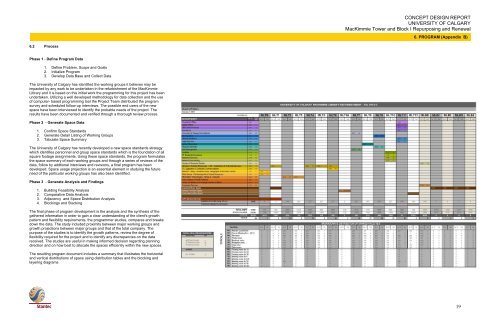DRAFT CONCEPT DESIGN REPORT UNIVERSITY OF CALGARY ...
DRAFT CONCEPT DESIGN REPORT UNIVERSITY OF CALGARY ...
DRAFT CONCEPT DESIGN REPORT UNIVERSITY OF CALGARY ...
Create successful ePaper yourself
Turn your PDF publications into a flip-book with our unique Google optimized e-Paper software.
6.2 Process<br />
Phase 1 - Define Program Data<br />
1. Define Problem, Scope and Goals<br />
2. Initialize Program<br />
3. Develop Data Base and Collect Data<br />
The University of Calgary has identified the working groups it believes may be<br />
impacted by any work to be undertaken in the refurbishment of the MacKimmie<br />
Library and it is based on this initial work the programming for this project has been<br />
undertaken. Utilizing a well developed methodology for data collection and the use<br />
of computer- based programming tool the Project Team distributed the program<br />
survey and scheduled follow-up interviews. The possible end users of the new<br />
space have been interviewed to identify the probable needs of the project. The<br />
results have been documented and verified through a thorough review process.<br />
Phase 2 - Generate Space Data<br />
1. Confirm Space Standards<br />
2. Generate Detail Listing of Working Groups<br />
3. Tabulate Space Summary<br />
The University of Calgary has recently developed a new space standards strategy<br />
which identifies personnel and group space standards which is the foundation of all<br />
square footage assignments. Using these space standards, the program formulates<br />
the space summary of each working groups and through a series of reviews of the<br />
data, follow by addtional interviews and revisions, a final program has been<br />
developed. Space usage projection is an essential element in studying the future<br />
need of the particular working groups has also been identified.<br />
Phase 3 - Generate Analysis and Findings<br />
1. Building Feasibility Analysis<br />
2. Comparative Data Analysis<br />
3. Adjacency and Space Distribution Analysis<br />
4. Blockings and Stacking<br />
The final phase of program development is the analysis and the synthesis of the<br />
gathered information in order to gain a clear understanding of the client's growth<br />
pattern and flexibility requirements, the programmer studies, compares and breaks<br />
down the data. The study included proximity between major working groups and<br />
growth projections between major groups and that of the total company. The<br />
purpose of the studies is to identify the growth patterns, review the degree of<br />
flexibility required for the project and to identify any discrepancies on the data<br />
received. The studies are useful in making informed decision regarding planning<br />
direction and on how best to allocate the spaces efficiently within the new spaces.<br />
The resulting program document includes a summary that illustrates the horizontal<br />
and vertical distributions of space using distribution tables and the blocking and<br />
layering diagrams<br />
<strong>CONCEPT</strong> <strong>DESIGN</strong> <strong>REPORT</strong><br />
<strong>UNIVERSITY</strong> <strong>OF</strong> <strong>CALGARY</strong><br />
MacKimmie Tower and Block I Repurposing and Renewal<br />
6. PROGRAM (Appendix B)<br />
19

















